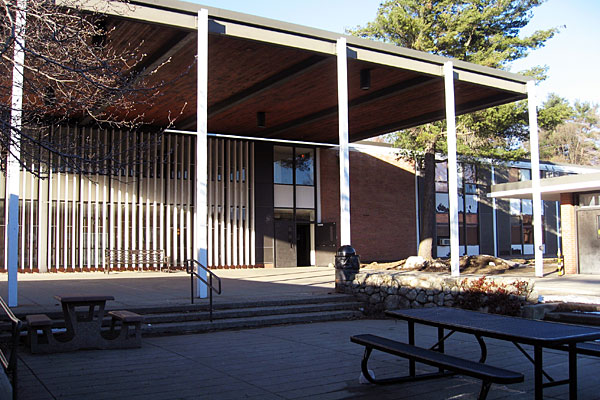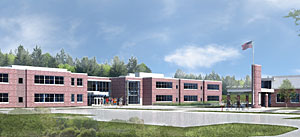 |
| Photo © Christine Cipriani |
|
Wayland High School, designed by The Architects Collaborative, opened in 1960. With the exception of the field house, the complex will be razed. |
Among the many schools designed by The Architects Collaborative (TAC), the noted Cambridge firm cofounded by Walter Gropius, Wayland High School was an instant emblem of midcentury design and educational innovation when it opened in 1960. Now, its days are numbered.
The school’s building committee says the 118,000-square-foot complex, located west of Boston, is in need of major, costly renovations. The committee voted in 2009 to tear down all but one of the eight TAC buildings to make way for a new facility designed by HMFH Architects. Construction has begun, and the old complex will be razed next year. Despite the school’s history, the looming demolition has stirred little controversy.

Designed by TAC's John C. “Chip” Harkness and Herbert Gallagher, the original 1960 complex comprises five academic buildings with outdoor circulation and a spectacular domed field house with bulbous skylights (the field house will be saved and restored). TAC later added two structures: another classroom building (1966) and a library and administration building (1972). By pulling students outdoors between classes, the campus fosters a collegiate atmosphere. “It’s significant in terms of modern architecture in suburbs,” says Doris Cole, FAIA, author of School Treasures: Architecture of Historic Boston Schools, “because it gives a very particular point of view…about how people should connect to the world around them.”
Like many Sputnik-era initiatives, the school represented an impulse to double down on academic rigor. Wayland was a pioneer in the use of faculty departments, then a new concept developed by Harvard Graduate School of Education Dean Francis Keppel. With buildings devoted to subject areas and rooms that varied in size, teachers could collaborate with peers, delegate clerical work, and advance their new mission to address students' differing needs. “I do recall it as being an interesting job to work on,” says Harkness. “They were approaching [things] in a slightly different way.”
When it opened, the school was featured in The New York Times, RECORD, Time, and Life, along with The Nation’s Schools, where it appeared on the cover with the headline “Secondary School of the Future?” Architectural Forum called Wayland “probably the most talked-about school plant in the U.S.,” and the Ford Foundation flew 60 school superintendents to the school as part of a national tour of inventive educational buildings.
But today’s teachers want larger classrooms, better technology, and interdisciplinary meeting space. Plus, Wayland’s faults are now legion, including roof overhangs that have shed chunks of concrete, inadequate wiring, outdated lab facilities, lack of ADA and fire-code compliance, poor air and lighting quality, and the presence of asbestos.
In response to pleas from the community, including alumni, the new school will feature a courtyard that preserves the spirit of the TAC complex, says school principal Patrick Tutwiler. “The open campus feel, the ability to move about and not be cooped up in a building all day—that was the one thing they really, really wanted to protect,” he says.



Post a comment to this article
Report Abusive Comment